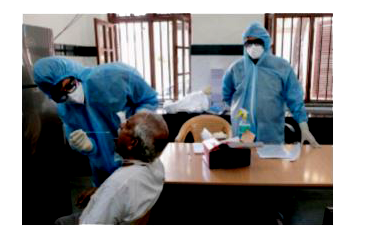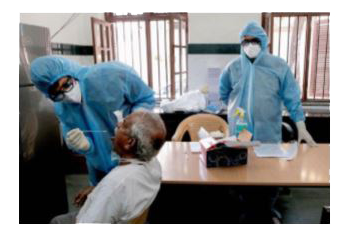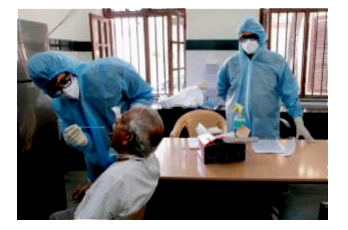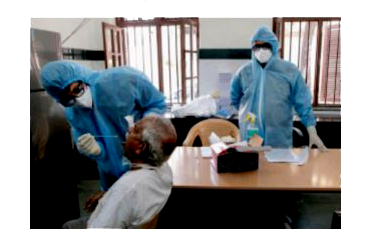Suppose that the reliability of a HIV test is specified as follows: Of people having HIV. 90% of the test detects the disease but 10% go undetected. Of people free of HIV, 99% of the test are judged HIV-ive but 1% are diagnosed as showing HIV+ive. From a large population of which only 0.1% have HIV one person is selected at random, given the HIV test, and the pathologist reports him/her as HIV+ive. What is the probability that the person actually has HIV?
To solve the problem, we will use Bayes' theorem to find the probability that a person actually has HIV given that they tested positive for it.
1. Define Events:
- Let E: the event that the person has HIV.
- Let F: the event that the person does not have HIV.
- Let G: the event that the test result is positive.
2. Given Information:
- The probability that a randomly selected person has HIV:
P(E)=0.001(0.1%)
- The probability that a randomly selected person does not have HIV:
P(F)=1−P(E)=1−0.001=0.999
- The probability that the test is positive given that the person has HIV:
P(G|E)=0.9(90%)
- The probability that the test is positive given that the person does not have HIV:
P(G|F)=0.01(1%)
3. Apply Bayes' Theorem:
We want to find P(E|G):
P(E|G)=P(G|E)⋅P(E)P(G)
where P(G) can be calculated using the law of total probability:
P(G)=P(G|E)⋅P(E)+P(G|F)⋅P(F)
4. Calculate P(G):
P(G)=(0.9⋅0.001)+(0.01⋅0.999)
P(G)=0.0009+0.00999=0.01089
5. Substitute Values into Bayes' Theorem:
P(E|G)=0.9⋅0.0010.01089
P(E|G)=0.00090.01089≈0.0828
6. Final Result:
The probability that the person actually has HIV given that they tested positive is approximately:
P(E|G)≈0.0828or8.28%
- Let E: the event that the person has HIV.
- Let F: the event that the person does not have HIV.
- Let G: the event that the test result is positive.
- The probability that a randomly selected person has HIV:
P(E)=0.001(0.1%)
- The probability that a randomly selected person does not have HIV:
P(F)=1−P(E)=1−0.001=0.999
- The probability that the test is positive given that the person has HIV:
P(G|E)=0.9(90%)
- The probability that the test is positive given that the person does not have HIV:
P(G|F)=0.01(1%)
We want to find P(E|G):
P(E|G)=P(G|E)⋅P(E)P(G)
where P(G) can be calculated using the law of total probability:
P(G)=P(G|E)⋅P(E)+P(G|F)⋅P(F)
P(G)=(0.9⋅0.001)+(0.01⋅0.999)
P(G)=0.0009+0.00999=0.01089
P(E|G)=0.9⋅0.0010.01089
P(E|G)=0.00090.01089≈0.0828
The probability that the person actually has HIV given that they tested positive is approximately:
P(E|G)≈0.0828or8.28%
Topper's Solved these Questions
- BOOK - NCERTCHAPTER - PROBABILITYEXERCISE - EXERCISE 13.117videos
PROBABILITY
- BOOK - NCERTCHAPTER - PROBABILITYEXERCISE - MISCELLANEOUS EXERCISE19videos
PROBABILITY
- BOOK - NCERTCHAPTER - PROBABILITYEXERCISE - Exercise 13.417videos
PROBABILITY
- BOOK - NCERTCHAPTER - MATRICESEXERCISE - EXERCISE 3.312videos
MATRICES
- BOOK - NCERTCHAPTER - RELATIONS AND FUNCTIONSEXERCISE - EXERCISE 1.314videos
RELATIONS AND FUNCTIONS
Similar Questions
The reliability of a COVID PCR test is specified as follows
Of people having COVID, 90% of the test detects the disease but 10% goes undetected. Of people free of COVID, 99% of the test is judged COVID negative but 1% are diagnosed as showing COVID positive. From a large population of which only 0.1% have COVID, one person is selected at random, given the COVID PCR test, and the pathologist reports him/her as COVID positive.

Based on the above information, answer the following
What is the probability that the ‘person is actually having COVID given that ‘he is tested as COVID positive’?View SolutionThe reliability of a COVID PCR test is specified as follows
Of people having COVID, 90% of the test detects the disease but 10% goes undetected. Of people free of COVID, 99% of the test is judged COVID negative but 1% are diagnosed as showing COVID positive. From a large population of which only 0.1% have COVID, one person is selected at random, given the COVID PCR test, and the pathologist reports him/her as COVID positive.

Based on the above information, answer the following
What is the probability of the ‘person to be tested as COVID positive’ given that ‘he is actually having COVID?View Solution
Knowledge Check
- Question 1 - Select One
HIV is a-
ACombination of disease symptomsBDevelopmental indexCViral diseaseDRetrovirus - Question 2 - Select One
HIV is related to
ACancerBPlagueCHepetitiesDAIDS. - Question 3 - Select One
HIV infects
ARBCBT – helper cellsCB - cellsDBasophils
The reliability of a COVID PCR test is specified as follows
Of people having COVID, 90% of the test detects the disease but 10% goes undetected. Of people free of COVID, 99% of the test is judged COVID negative but 1% are diagnosed as showing COVID positive. From a large population of which only 0.1% have COVID, one person is selected at random, given the COVID PCR test, and the pathologist reports him/her as COVID positive.

Based on the above information, answer the following
What is the probability of the ‘person to be tested as COVID positive’ given that ‘he is actually not having COVID’?View SolutionThe reliability of a COVID PCR test is specified as follows
Of people having COVID, 90% of the test detects the disease but 10% goes undetected. Of people free of COVID, 99% of the test is judged COVID negative but 1% are diagnosed as showing COVID positive. From a large population of which only 0.1% have COVID, one person is selected at random, given the COVID PCR test, and the pathologist reports him/her as COVID positive.

Based on the above information, answer the following
What is the probability that the ‘person selected will be diagnosed as COVID positive’?View SolutionThe reliability of a COVID PCR test is specified as follows
Of people having COVID, 90% of the test detects the disease but 10% goes undetected. Of people free of COVID, 99% of the test is judged COVID negative but 1% are diagnosed as showing COVID positive. From a large population of which only 0.1% have COVID, one person is selected at random, given the COVID PCR test, and the pathologist reports him/her as COVID positive.

Based on the above information, answer the following
What is the probability that the ‘person is actually not having COVID?View SolutionHIV attacks
View SolutionIn human body ,HIV attacks mainly
View Solution

